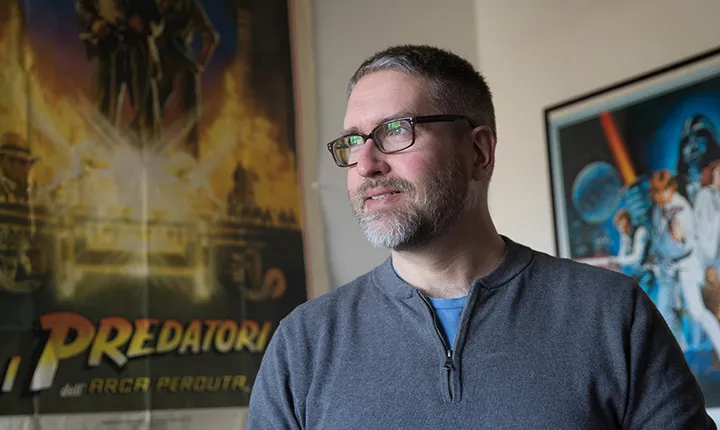More than Meets the Eye

In his new book, Associate Professor of Film and Media Studies Bob Rehak explores how special effects influence storytelling and worldbuilding in cinema.
Produced by Thomas Edison, the 1895 short historical film The Execution of Mary, Queen of Scots contains perhaps the first-ever movie special effect. Via a deceptively simple trick—a quick camera cut seamlessly swaps an actress for a mannequin—director Alfred Clark created an illusion so convincing many viewers believed they were actually witnessing a beheading.
Since then, we’ve all lost our heads for increasingly sophisticated displays of screen magic that reshaped not only the cinematic landscape, but the business and cultural ones as well. This is epitomized by such blockbuster multiplatform properties as Star Trek, Star Wars, The Matrix, Harry Potter, and The Lord of the Rings, according to Associate Professor of Film and Media Studies and department chair Bob Rehak in his new book, More Than Meets the Eye: Special Effects and the Fantastic Transmedia Franchise (NYU Press).
“I wanted to talk about big franchises that really aren’t behaving like movies anymore—they’re bigger than movies, and they spawn different types of texts and subtexts—by looking at them as narratives of special effects,” he says. “My book is written from the perspective of, ‘Let’s talk about how special effects work in stories and how they mediate our beliefs about the industry.’”
For example, one chapter of More Than Meets the Eye focuses on the changing nature of screen performances, exemplified by the near-universal critical and commercial acclaim for Andy Serkis’s indelibly human but computer-generated characters in the Planet of the Apes, Lord of the Rings, and Star Wars franchises.
“People are waiting for the point at which we’ll watch a performance and only later learn if it was a special effect or not. I don’t think that point will ever come,” he says. “To me, what’s interesting about special effects is they’re a way of maintaining certain distinctions between the organic and technical, and we need that reminder.”
Rehak’s interest in film and special effects dates back to his childhood love of the classic monster movies, like Frankenstein (1931) and King Kong (1933), on the small screen and exciting genre fare like Clash of the Titans (1981) and Tron (1982) on the big. As he grew from a fan to a student of film, he became more aware of the through-line that connects the earlier, carefully parceled-out artisanal special effects to today’s nonstop digital spectacles, and how our relationship to film has changed immeasurably in the last 50 years in particular.
“We all need to develop a critical appreciation of the intricacy and interconnectedness of our shared mediascape,” he says. “A phenomenon like Star Wars shows how a single film can spawn a mythology. Now, it’s become a cloud history of a kind we’re seeing more and more of, spawned around imaginary worlds and universes.
“What interests me is the idea of a collective post-World War II industry of hallucination developing alongside the emergence of ever-more elaborate ways of creating imagery: blockbuster film and media, comics and merchandise, toys and video games,” he adds. “We’ve become very, very good at substituting other worlds and experiences for our own.”
This dovetails into his next big project, a 100-plus year history of humanity’s collective imagining of outer space: the reality of scientific exploration interacting with the fantasy of science fiction.
“Think about every movie you’ve ever seen, every comic you’ve ever read, every show you’ve ever watched, that takes place in space. Unless you’re an astronaut who has actually left the planet, the only way you’ve been there is through representations in visual culture,” he says. “Looking back over the decades, it seems like we came to a fork in the road between a path outward and a path inward, and we opted for the latter so that special effects are mediating our experience of the solar system and the rest of the universe.”



